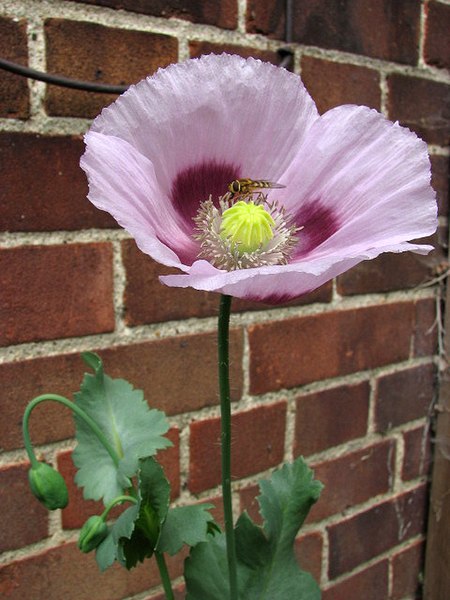File:Opium poppy (Papaver somniferum) - geograph.org.uk - 858005.jpg
From Wikimedia Commons, the free media repository
Jump to navigation
Jump to search

Size of this preview: 450 × 600 pixels. Other resolutions: 180 × 240 pixels | 480 × 640 pixels.
Original file (480 × 640 pixels, file size: 197 KB, MIME type: image/jpeg)
File information
Structured data
Captions
Captions
Opium poppy (Papaver somniferum)
Summary
[edit]| DescriptionOpium poppy (Papaver somniferum) - geograph.org.uk - 858005.jpg |
English: Opium poppy (Papaver somniferum). The opium poppy is an annual herb and one of the most important medicinal plants, native to Southeastern Europe and western Asia; it is cultivated extensively in many countries, including Iran, Turkey, Holland, Poland, Romania, Czechoslovakia, Yugoslavia, India, Canada, and many Asian and Central and South American countries and has a tremendous impact on several societies as an opiate. A milky exudation is collected from incisions made in the walls of the green seed pods and the alkaloids are separated when dry. Opium and its derivatives are used in the pharmacceutical industry as narcotic anagelsics, hypnotics and sedatives. Opium is used in the production of morphine and codeine, morphine being the raw material from which heroin is obtained. Opium and the drugs derived from it are addictive and can have toxicological effects. Poppy seeds are used as a condiment with baked goods and pastries and poppy oil is widely used for cooking, in the manufacture of paints, varnishes and soaps. Many older homes have opium poppies growing in their gardens.
In 2006, the British government permitted the pharmaceutical company Macfarlan Smith to cultivate opium poppies in England for medicinal reasons in order to meet the high demand for morphine and heroin. Opium poppy cultivation in the United Kingdom does not need a licence but a licence is required for those wishing to extract opium for medicinal products. |
| Date | |
| Source | From geograph.org.uk |
| Author | Evelyn Simak |
| Attribution (required by the license) InfoField | Evelyn Simak / Opium poppy (Papaver somniferum) / |
InfoField | Evelyn Simak / Opium poppy (Papaver somniferum) |
| Camera location | 52° 50′ 39″ N, 1° 16′ 02″ E | View this and other nearby images on: OpenStreetMap |
|---|
| Object location | 52° 50′ 40″ N, 1° 16′ 03″ E | View this and other nearby images on: OpenStreetMap |
|---|
Licensing
[edit]
|
This image was taken from the Geograph project collection. See this photograph's page on the Geograph website for the photographer's contact details. The copyright on this image is owned by Evelyn Simak and is licensed for reuse under the Creative Commons Attribution-ShareAlike 2.0 license.
|
This file is licensed under the Creative Commons Attribution-Share Alike 2.0 Generic license.
Attribution: Evelyn Simak
- You are free:
- to share – to copy, distribute and transmit the work
- to remix – to adapt the work
- Under the following conditions:
- attribution – You must give appropriate credit, provide a link to the license, and indicate if changes were made. You may do so in any reasonable manner, but not in any way that suggests the licensor endorses you or your use.
- share alike – If you remix, transform, or build upon the material, you must distribute your contributions under the same or compatible license as the original.
File history
Click on a date/time to view the file as it appeared at that time.
| Date/Time | Thumbnail | Dimensions | User | Comment | |
|---|---|---|---|---|---|
| current | 02:55, 21 February 2011 |  | 480 × 640 (197 KB) | GeographBot (talk | contribs) | == {{int:filedesc}} == {{Information |description={{en|1=Opium poppy (Papaver somniferum) The opium poppy is an annual herb and one of the most important medicinal plants, native to Southeastern Europe and western Asia; it is cultivated extensively in man |
You cannot overwrite this file.
File usage on Commons
There are no pages that use this file.
Metadata
This file contains additional information such as Exif metadata which may have been added by the digital camera, scanner, or software program used to create or digitize it. If the file has been modified from its original state, some details such as the timestamp may not fully reflect those of the original file. The timestamp is only as accurate as the clock in the camera, and it may be completely wrong.
| Camera manufacturer | Canon |
|---|---|
| Camera model | Canon PowerShot S3 IS |
| Exposure time | 1/125 sec (0.008) |
| F-number | f/5 |
| Date and time of data generation | 10:12, 23 June 2008 |
| Lens focal length | 6 mm |
| Orientation | Normal |
| Horizontal resolution | 180 dpi |
| Vertical resolution | 180 dpi |
| Software used | Adobe Photoshop CS Windows |
| File change date and time | 12:07, 24 June 2008 |
| Y and C positioning | Centered |
| Custom image processing | Normal process |
| Exposure mode | Manual exposure |
| White balance | Auto white balance |
| Digital zoom ratio | 1 |
| Scene capture type | Standard |
| Exif version | 2.2 |
| Date and time of digitizing | 10:12, 23 June 2008 |
| Image compression mode | 3 |
| APEX shutter speed | 6.96875 |
| APEX aperture | 4.65625 |
| Maximum land aperture | 2.875 APEX (f/2.71) |
| Metering mode | Spot |
| Flash | Flash did not fire, compulsory flash suppression, red-eye reduction mode |
| Color space | sRGB |
| Focal plane X resolution | 2,840.2366863905 |
| Focal plane Y resolution | 2,844.4444444444 |
| Focal plane resolution unit | inches |
| Sensing method | One-chip color area sensor |